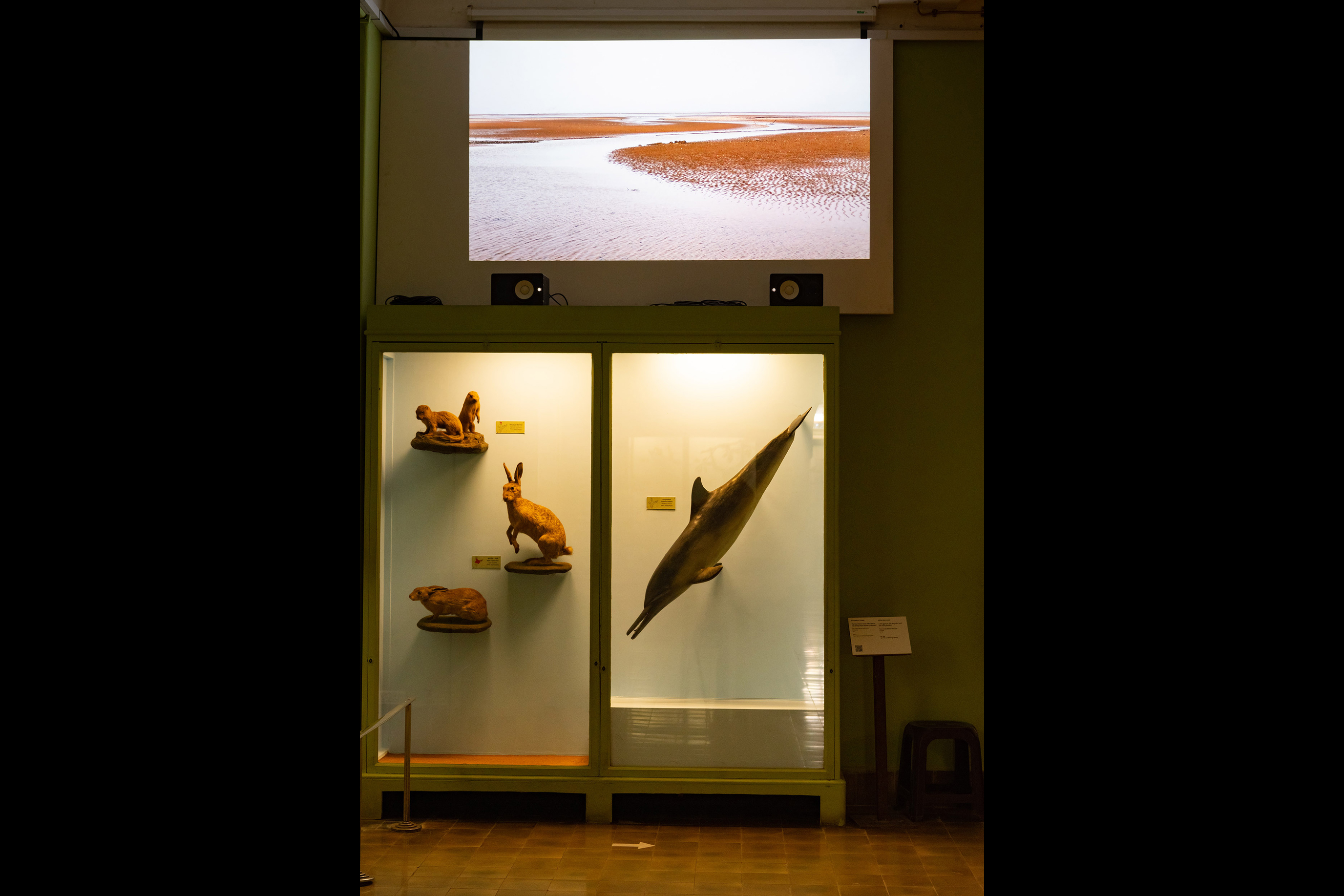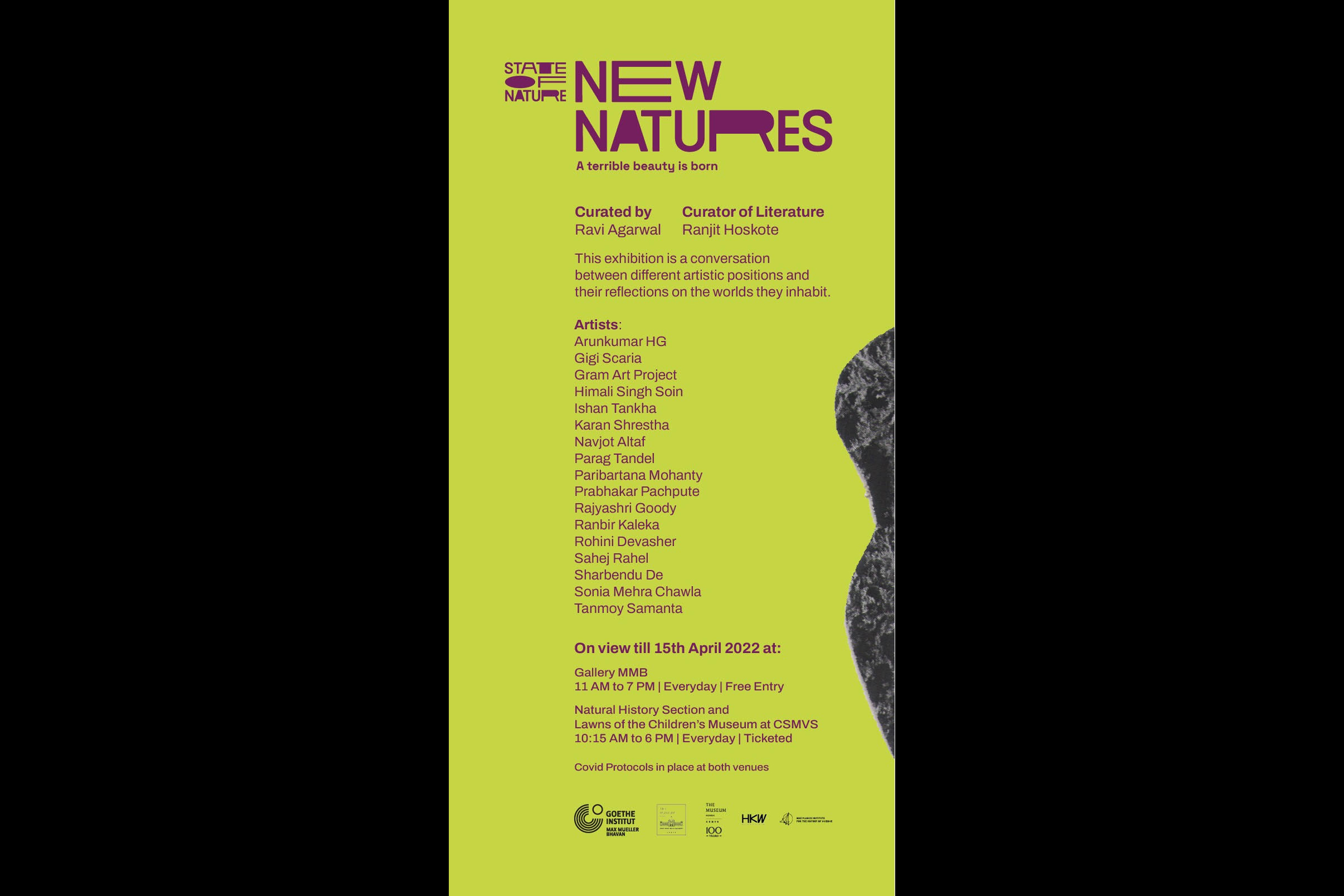

|
NEW NATURES: A TERRIBLE BEAUTY IS BORN INTERDISCIPLINARY ART EXHIBITION AND SEMINAR Initiated by Goethe-Institut / Max Mueller Bhavan Mumbai In collaboration with CSMVS Museum, Mumbai | |
|
Curator: Ravi Agarwal Curator of Literature: Ranjit Hoskote Venue: CSMVS Museum, Mumbai (Natural History Galleries) & Gallery MMB, Goethe-Institut APRIL-JUNE 2022 |
|
 | |
|
NEW NATURES: A TERRIBLE BEAUTY IS BORN "New Natures: A Terrible Beauty is Born" curated by Ravi Agarwal is the next iteration of State of Nature – a project initiated by Goethe-Institut / Max Mueller Bhavan Mumbai in 2018 that brings together multiple perspectives to understand and address our present ecological crisis. This exhibition is a proposition to rethink the world as we know it today. As Curator of Literature, Ranjit Hoskote has conceptualised a programme consisting of prominent writers, poets, and essayists that intervenes the exhibition. Participating artists: Arunkumar H G, Gigi Scaria, Gram Art Project, Himali Singh Soin, Ishan Tankha, Karan Shrestha, Navjot Altaf, Parag Tandel, Paribartana Mohanty, Prabhakar Pachpute, Rajyashri Goody, Ranbir Kaleka, Rohini Devasher, Sahej Rahel, Sharbendu De, Sonia Mehra Chawla, Tanmoy Samanta (Click here) SONIA MEHRA CHAWLA: FEARTURED WORK AT CSMVS MUSEUM, MUMBAI NATURAL HISTORY GALLERIES Working with archival historical microscope slides, ‘living’ material from the North Sea and Atlantic Ocean, and filmed through microscopes, ‘Vital to Life’ makes the invisible, mysterious and enigmatic world of microorganisms visible, revealing hidden worlds lying beyond the scope of the human eye. Drawing on the inspirational work of evolutionary theorist and biologist Lynn Margulis and animal physiologist and biochemist Prof. Margaret McFall-Ngai, ‘Vital To Life’ reimagines an oceanic worldview of entangled histories, symbiotic relationships and contaminations. The series has been realized within the framework of ‘Entanglements of Time & Tide’, a visual arts and science engagement project by Sonia that explores the North Sea and its tidal zones through an ecological, political, poetic, cultural and economic lens. Reflecting on the human impact on our environment, and in particular effects on micro-organisms by capital-intensive heavy industry and anthropogenic activities, the project explores the enigmatic life of planktons providing several entry points to understanding larger global issues associated with the world’s oceans, while investigating the impact of technological obsolescence, the drive to consumption and the impacts of the waste created by these technofossils. The project has been facilitated and supported by Edinburgh Printmakers, Marine Scotland, Creative Scotland, ASCUS Art & Science, Marine Laboratory of the Scottish Government in Aberdeen, Historic Environment Scotland, Edinburgh Science Festival 2021 and Edinburgh Art Festival 2021. Location: Natural History Section, CSMVShttp://www.aestheticamagazine.com/co INSTALLATION VIEWS CSMVS MUSEUM, MUMBAI NATURAL HISTORY SECTION |
|
 |
 |
 |
||
 |
 |
 |
||
 |
 |
 |
||
 |
 |
 |
||
 |
 |
 |
||
 |
 |
 |
||
| http://www.aestheticamagazine.com/yinchuan-biennale-2016/http://www.aestheticamagazine.com/yinchuan-biennale-2016/ | ||||
| Works Vital To Life (2020-21) HD Video; 15 minutes 42 seconds (In collaboration with ASCUS Art & Science, Edinburgh, Marine Scotland and Edinburgh Science Festival 2021). Vital To Life: Drifters & Wanderers (2021) Series I-VIII, set of engravings paired with photomicrographs Engravings: Somerset Velvet with deckle edges, 300 gsm (100% cotton rag, mould made paper, acid-free and lignin-free), 76.2/55.9 cms each Photomicrographs: archival prints on Hahnemühle Museum Etching, 30.5/21 cms each In collaboration with Edinburgh Printmakers, ASCUS Art & Science and Marine Scotland UK. The Non-Human Touch (2021) What Values Can Emerge from Ruined Landscape? Film in high definition with sound, 45 minutes (In collaboration with ASCUS Art & Science, Edinburgh, Marine Scotland and Edinburgh Science Festival 2021.) ABOUT THE EXHIBITION “All changed, changed utterly: A terrible beauty is born” [Easter, 1916. The Collected Poems of W. B. Yeats (1989)] Climate change, environmental destruction, species extinctions, now increasingly common terms, are symptoms of a deeper planetary emergency. At its root lies an historical alienation from nature, which converted lived nature relationships to an abstract idea of separateness. Nature’s commodification converted its polyphonic values to a singular monetary one. A hyper-real metaverse technoshpere has further reduced complex ecosystems to mere data. Extractive, capital-technology driven economies – propelled by colonization and thoughtless industrialization – have caused planetary limits to be exceeded and have catapulted us into the Anthropocene. The recent zootonic viruses are a ‘phenomenon’ produced by the ‘intra-acting’ (in Karen Barad’s terms) networks of capital and its institutions, and harbingers of unfolding perils. Alongside, the entangled worlds of culture and nature, which we have gloriously inhabited for long are facing erasures. Recovering a heterogeneity of nature-cultures, not as a binary but as “culture enclosed in nature, (and) nature reworked in culture…” (A.K Ramanujan) is already a radical task today. Also, as biogenetics reveal, we are all but assemblages, who have co-evolved with other beings. We need to urgently find ways to embrace humbler, more inclusive existences with the more-than-human world. This exhibition is a proposition to rethink the world as we know it today. It is a conversation between different artistic positions and their reflections on the worlds they inhabit. It hopes to help invoke an ethics of healing, care, and responsibility. The artists and thinkers presented here have had long practices embedded in questions of nature. They search beyond disciplinary boundaries, to unearth relationships which form identity, language, politics, livelihoods, and worldviews. In doing so, they show how nature is being constantly ‘produced,’ through everyday local and situated knowledges, concerns, and struggles- presenting a counter narrative to its homogeneous and totalizing idea. They reveal the way we are, the way we have come to be, and the way we could be, in this viscous lava of precarious reformulations. As intimate listeners and makers of their worlds, they are harbingers of new futures. Ravi Agarwal Curator PRACTICES OF HOPE Fifty years ago, the Club of Rome’s seminal report, The Limits to Growth (1972), warned us of the catastrophe that would result from our reckless economic expansion and our relentless exploitation of the earth’s resources, a festival of greed unfolding like there was no tomorrow. Today, we stand at one of the most precarious thresholds in history, unsure of whether there will be a tomorrow. We have depleted our planet’s reserves of fossil fuel, poured toxins into its soil and released poisonous effluents into its air and water. We have brought about a rapid destruction of habitat for an alarmingly wide array of species. We have accelerated the release of greenhouse gases, punctured the ozone layer, and triggered off the melting of the Arctic and Antarctic ice caps and the degradation of the ice cover in the ‘Third Pole’, the Hindu Kush-Karakorum-Himalayan belt. This, in turn, has set in motion a rise in sea levels that threatens many of the world’s littoral cities – including Mumbai – with imminent flooding. Decades before this catastrophe overtook us, the anthropologist and cybernetics pioneer Gregory Bateson observed presciently that a species that outstrips its habitat is doomed. We are that species. We have imagined ourselves to be the owners of the earth, when we are merely its transient and wilful tenants. We have disregarded the rights and needs of the species that are our fellow tenants of this planet. With every step we take, every debt we owe to our ecosystems, we burden the earth and guarantee our own extinction as a species. How do we propose remedies and craft resolutions to this catastrophe? In New Natures, we bring together voices from the literary arts, the humanities, the sciences, and the domains of activism and architecture, to engage with the urgent question of how to live responsibly in a multispecies world. In the conference and the unfolding programme of literary events that are integral to this project, alongside this exhibition, we convene a group of poets, prose writers and thinkers who recall us to the replenishing practices of compassion, wisdom, solidarity, love, courage, and hope. Ranjit Hoskote Curator of Literature http://www.aestheticamagazine.com/yin/ |